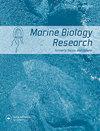热带气旋安潘对恒河河口桡足类的影响
IF 1.2
4区 生物学
Q4 ECOLOGY
引用次数: 0
摘要
本文章由计算机程序翻译,如有差异,请以英文原文为准。
Effects of tropical cyclone Amphan on the copepods of the Ganges estuary
ABSTRACT Tropical cyclones are increasingly affecting estuarine communities. The effects of category-5 tropical cyclone Amphan (landfall on 20 May 2020 near the Ganges estuary mouth) on the copepod community of the Ganges estuary were studied. Copepod assemblages were sampled before (February–December 2019), shortly after (31 May–12 June 2020) and post-(September–November 2020) Amphan periods. It was hypothesized that shortly after Amphan a relatively homogeneous community consisting of a few estuarine specialists would succeed but that would soon be replaced by a heterogeneous one; however, those specialists would continue their dominance. Shortly after Amphan species richness declined but the recovery process was completed within months, led by Paracalanus parvus, Bestiolina similis, Acartia spinicauda, Acartiella tortaniformis and Oithona brevicornis. Spatial homogeneity of the community that prevailed in pre- and shortly after Amphan was lost in post-Amphan. The unilateral dominance of B. similis observed in the pre-Amphan period was challenged by P. parvus, A. spinicauda, A. tortaniformis and O. brevicornis after Amphan. Shortly after Amphan A. spinicauda proliferated and co-dominated the estuary with A. tortaniformis but the latter replaced the former within a few months. The copepod community experienced rearrangements in species composition, abundance and dominance hierarchy; therefore, its regular monitoring is recommended.
求助全文
通过发布文献求助,成功后即可免费获取论文全文。
去求助
来源期刊

Marine Biology Research
生物-海洋与淡水生物学
CiteScore
2.10
自引率
0.00%
发文量
55
审稿时长
6-12 weeks
期刊介绍:
Marine Biology Research (MBRJ) provides a worldwide forum for key information, ideas and discussion on all areas of marine biology and biological oceanography. Founded in 2005 as a merger of two Scandinavian journals, Sarsia and Ophelia, MBRJ is based today at the Institute of Marine Research, Bergen, Norway. The Journal’s scope encompasses basic and applied research from all oceans and marine habitats and on all marine organisms, the main criterium for acceptance being quality.
 求助内容:
求助内容: 应助结果提醒方式:
应助结果提醒方式:


